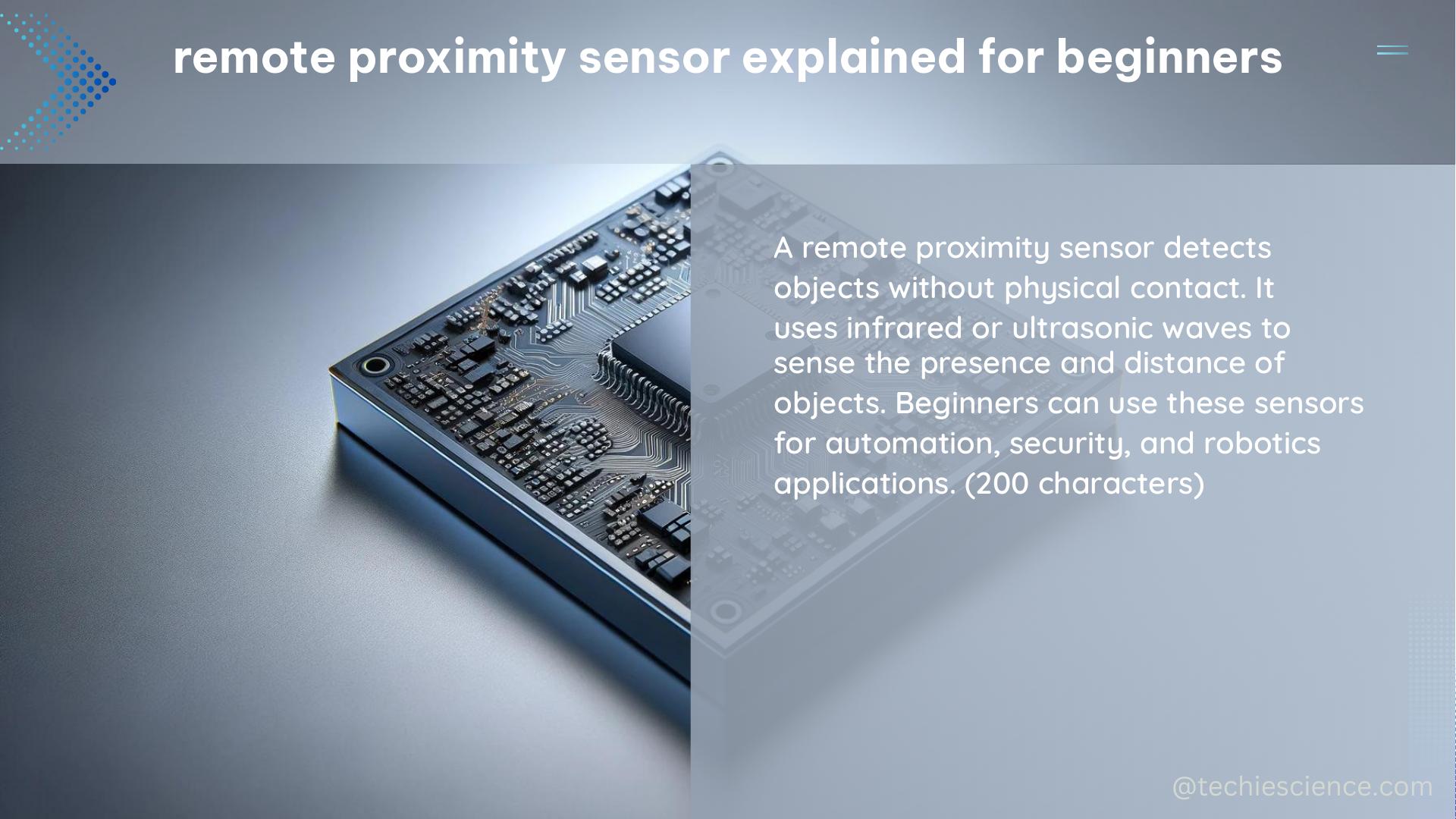Remote proximity sensors are essential components in various systems, including manufacturing, robotics, and automation. They detect the presence or absence of objects within their range without physical contact. This comprehensive guide will explain remote proximity sensors for beginners, focusing on technical specifications, hands-on details, and a DIY approach.
What is a Remote Proximity Sensor?
A remote proximity sensor is an electronic device that uses electromagnetic fields, acoustic waves, or infrared light to detect the presence or absence of objects within a specific range. These sensors are non-contact and provide a measurable output, typically a digital or analog signal, indicating the proximity of an object.
Technical Specifications of Remote Proximity Sensors

- Detection Technology:
- Remote proximity sensors can use various detection technologies, such as ultrasonic, infrared, or microwave.
- Ultrasonic sensors use high-frequency sound waves to detect objects, making them suitable for dusty or dirty environments.
- Infrared sensors use infrared light to detect objects, providing clear and precise object detection.
- Microwave sensors use electromagnetic waves to detect objects, offering a longer detection range compared to other technologies.
-
The choice of detection technology depends on the specific application requirements, such as the environment, object characteristics, and desired performance.
-
Range:
- The detection range of a remote proximity sensor varies from a few millimeters to several meters, depending on the sensor type and model.
- Ultrasonic sensors typically have a detection range of 10 cm to 6 m.
- Infrared sensors can detect objects within a range of 10 cm to 1 m.
-
Microwave sensors can detect objects within a range of 1 m to 30 m.
-
Output Signal:
- Remote proximity sensors can provide either an analog or digital output signal.
- Analog signals are continuous and provide more precise distance measurements, with outputs ranging from 0-10V or 4-20mA.
-
Digital signals indicate only the presence or absence of an object within the sensor’s range, with outputs such as 0/1 or ON/OFF.
-
Power Supply:
- Remote proximity sensors can be powered by various voltage sources, typically ranging from 5V to 24V.
-
The power supply must be compatible with the selected sensor to ensure proper operation.
-
Environmental Factors:
- Remote proximity sensors can be affected by environmental factors such as temperature, humidity, and electromagnetic interference.
- Selecting a sensor with the appropriate environmental ratings and protection is crucial to ensure reliable performance in the intended application.
Hands-On Details and DIY Approach
To use a remote proximity sensor, follow these steps:
- Select the Appropriate Sensor Technology:
-
Choose the sensor technology (ultrasonic, infrared, or microwave) that best suits your application requirements, such as the environment, object characteristics, and desired performance.
-
Determine the Required Detection Range and Output Signal:
-
Identify the necessary detection range and output signal (analog or digital) for your application, and select a sensor that meets these requirements.
-
Power the Sensor Appropriately:
-
Ensure that the sensor’s power supply is compatible with the selected sensor and provides the correct voltage and current.
-
Mount the Sensor in the Appropriate Location:
-
Position the sensor to detect the desired objects and protect it from environmental factors that may affect its performance.
-
Connect the Sensor to the Control System:
- Use the appropriate wiring and connectors to connect the sensor to the control system, and configure the system to interpret the sensor’s output signal correctly.
Measurable and Quantifiable Data on Remote Proximity Sensors
Here are some typical performance specifications for different types of remote proximity sensors:
| Sensor Type | Detection Range | Angular Field of View | Output Signal |
|---|---|---|---|
| Ultrasonic | 10 cm to 6 m | ±15° | 0-10V or 4-20mA |
| Infrared | 10 cm to 1 m | ±30° | 0-5V or 0-10V |
| Microwave | 1 m to 30 m | ±30° | 0-5V or 0-10V |
These specifications provide a general overview of the capabilities of different remote proximity sensor technologies. However, it’s important to consult the manufacturer’s data sheets for the specific sensor model you intend to use, as performance can vary depending on the sensor’s design and features.
References
- Human Systems Integration (HSI) Practitioner’s Guide
- THREE APPROACHES TO ORGANIZATIONAL LEARNING
- Innovation for maintenance technology improvements – GovInfo

The lambdageeks.com Core SME Team is a group of experienced subject matter experts from diverse scientific and technical fields including Physics, Chemistry, Technology,Electronics & Electrical Engineering, Automotive, Mechanical Engineering. Our team collaborates to create high-quality, well-researched articles on a wide range of science and technology topics for the lambdageeks.com website.
All Our Senior SME are having more than 7 Years of experience in the respective fields . They are either Working Industry Professionals or assocaited With different Universities. Refer Our Authors Page to get to know About our Core SMEs.